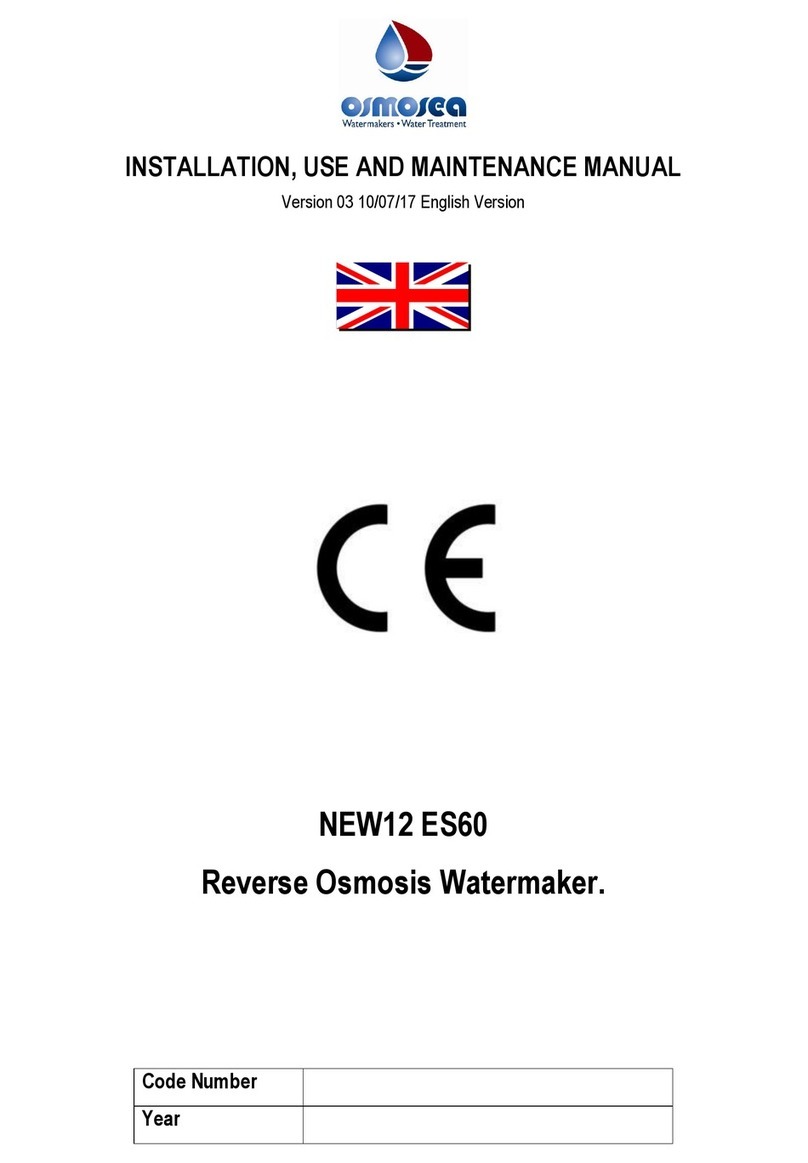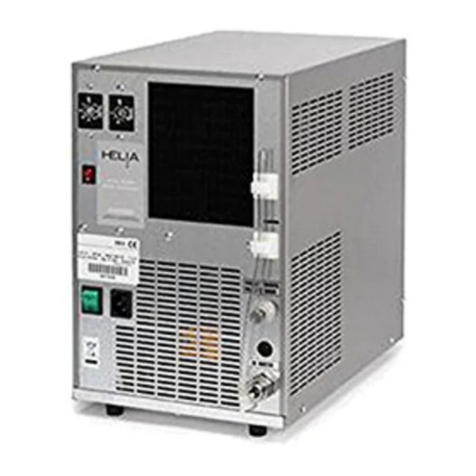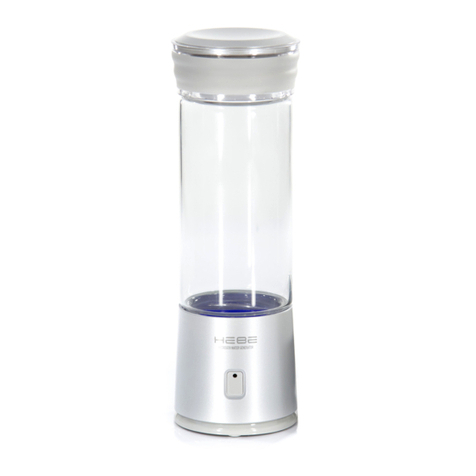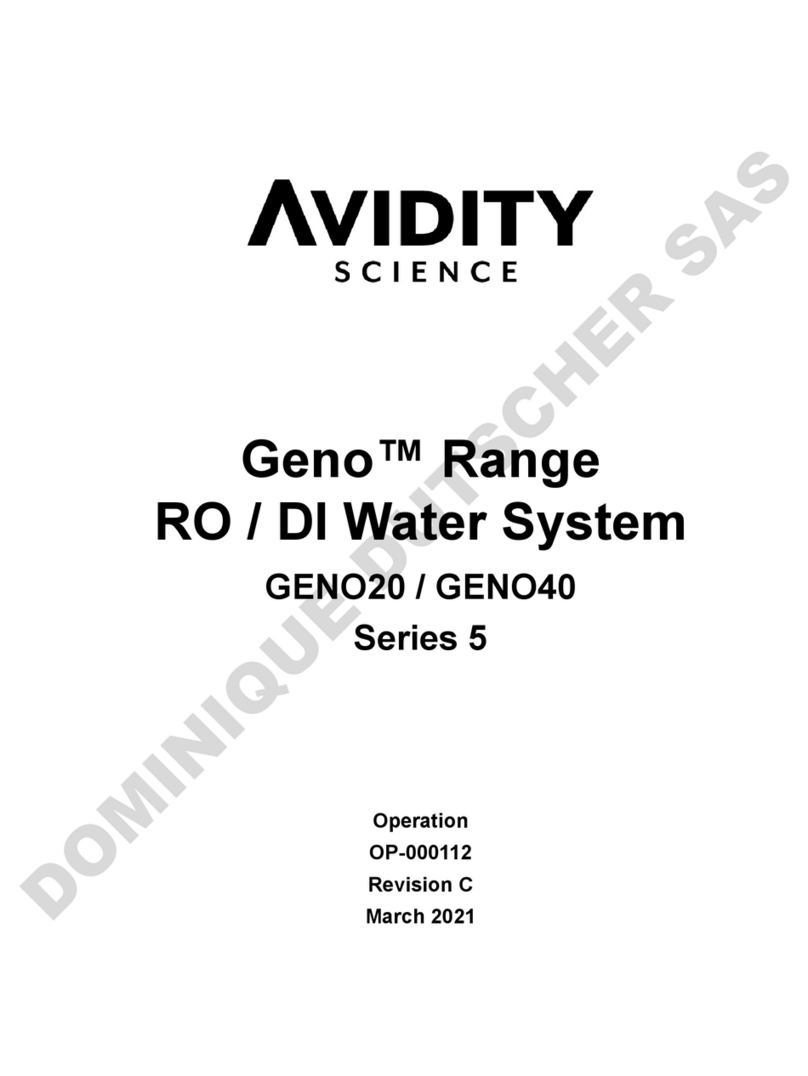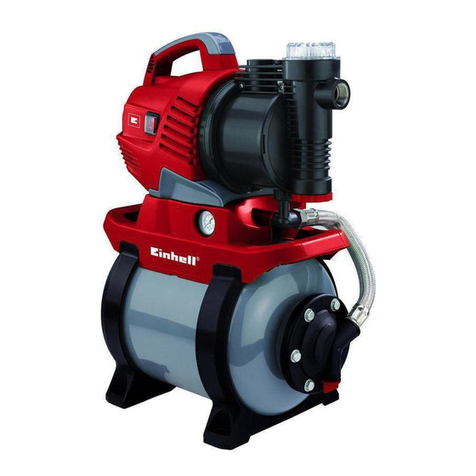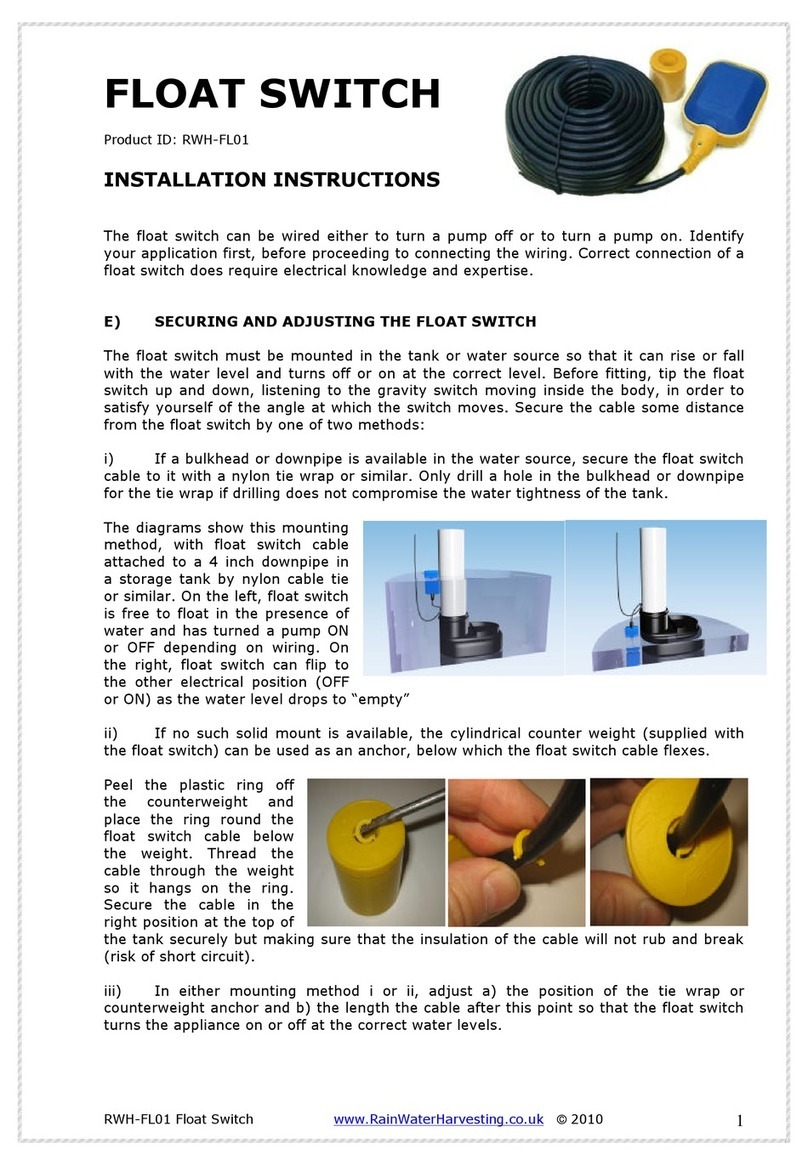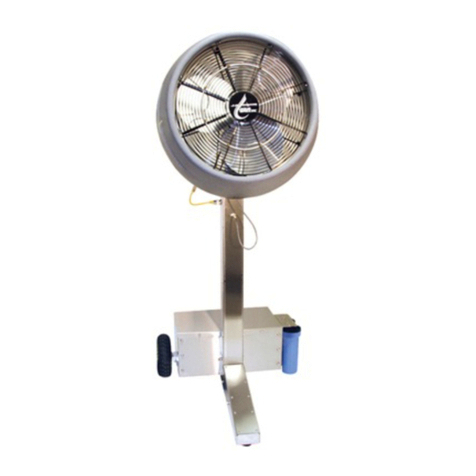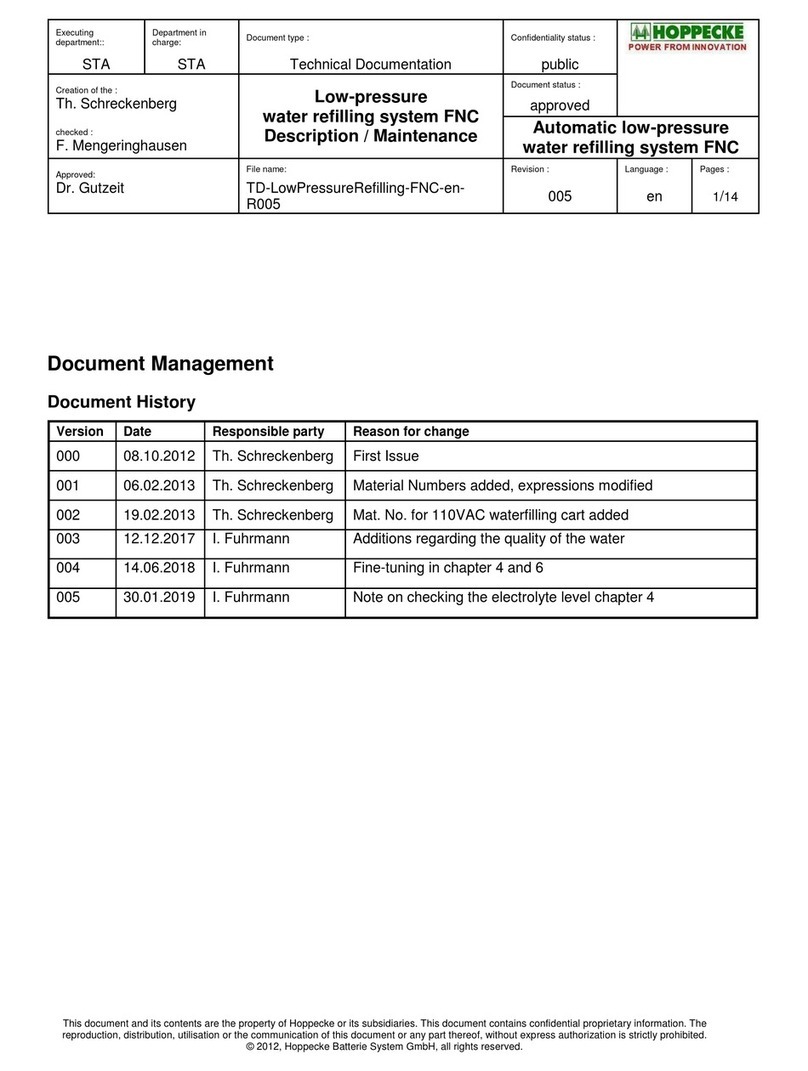OSMOSEA EVO 300 Service manual

INSTALLATION, USE AND MAINTENANCE MANUAL
Version 03 16/11/17
English Version
OSMOSEA EVO 300
Reverse Osmosis Watermaker.
Code Number
190506D285
Year
05/2019

Installation, Use and Maintenance Manual
2
Index
GENERAL PREMISE.........................................................................................................................3
WARRANTEE....................................................................................................................................4
GENERAL PRINCIPLES OF SAFETY...............................................................................................5
TECHNICAL DATA ............................................................................................................................6
INSTALLATION .................................................................................................................................8
ABOUT REVERSE OSMOSIS.........................................................................................................12
INSTRUCTION FOR THE OPERATION OF THE PLANT................................................................14
MAINTENANCE...............................................................................................................................17
TROUBLESHOOTING GUIDE.........................................................................................................21
DEMOLITION AND DISPOSAL OF THE PLANT .............................................................................21
DECLARATION OF CONFORMITY.................................................................................................22

Installation, Use and Maintenance Manual
3
GENERAL PREMISE
This documentation is an integral part of the plant and provides information necessary for the:
Machine identification;
Presence of risk factors on the plant
Overall dimensions and characteristics of the plant
Installation’s rules
Use and maintenance instruction
Warnings
This CPS is an integral part of the technical documentation of the machine used for water treatment.
The instructions are designed both to protect the physical integrity of the person using the machine, and to
provide guidance regarding the most appropriate behavior for the proper use of the machine, as suggested
by OSMOSEA SRL.
Given the importance of this manual in terms of safety, please read it carefully before using the plant and re-
read it when difficulties or concerns arise.
The manual must be stored carefully, and made widely available to all persons concerned; we recommend
not alter or remove any information that are needed to identify the plant.
Manufacturer’s Info
For any need OSMOSEA SRL is at your entire disposal to provide you with technical assistance to resolve
any problems and organize at best any sort of interventions.
OSMOSEA SRL
Via Dante Alighieri, 7 –91025 Marsala (TP)
Tel. +39 0923 719867
Fax +39 0923 569793
www.osmosea.it

Installation, Use and Maintenance Manual
4
Plant’s ID
The plant is identified through an adhesive plate in which is reported the details to be quoted to OSMOSEA
Srl in case of need, this plaque is the only one recognized by the manufacturer as means of identification of
the product.
WARRANTEE
Osmosea srl ensures this plant in the following terms and conditions:
1.The Seller guarantees the product to be free from defects in material and workmanship under normal use
in accordance with the directions given in the technical literature for a period of 24 months after delivery to
customer and agrees to repair or replace, at its option, the product at no charge should it become defective
and which its examination shall disclose to be defective and under warranty. All defective products shall be
returned to Seller. carriage paid. The guarantee shall expire 24 months after delivery to customer even in the
event that the product has not been used for whatever reason.
2.All descriptive specifications and particulars of weights and dimensions laid down in catalogues. quotations
or order confirmations are approximate only. The Seller reserves the right to make any modifications and
improvements to its products which it may deem desirable or opportune without prior notice.
3.The guarantee does not extend to any of the Seller's products which have been subjected to neglect,
misuse, incorrect maintenance, tampering with on the part of the Purchaser or of third parties, improper
installation, or to use in violation of instructions supplied by the Seller, or any other reasons whatsoever
beyond Seller's control.
The Seller shall not be held responsive for damage to goods during loading, transport and unloading, All
claims for any such damage must be put forth to the carrier at the time of delivery. Goods shall be properly
packed and protected.
4.In the event that Purchaser sells the goods to third parties, Purchaser shall undertake to provide any such
third parties with all technical information and instructions furnished to it by the Seller, otherwise the
guarantee shall became null and void.
The guarantee shall not cover any damage or failures resulting from exceptional circumstances.
5.Any claim for damage or latent defects must be made in writing within eight days from the date of
discovery, otherwise they shall not be considered.
6.Whenever products are returned, this shall not mean automatically that they were found to be defective
unless a specific claim to this effect has been put forth.
7.Should a defect be suspected, Purchaser shall submit to Seller a request for repair or replacement of the
defective product and Seller shall repair or replace at no charge any such product which its examination shall
disclose to be defective In material and workmanship, Any such defective products shall be repaired at the
Seller's works. Any defects in a particular product shall not form the subject of a claim for a full consignment
of products that includes several types of products. Purchaser shall not therefore be entitled to withhold
payment of any products other than those which are the subject of the claim.
8.In respect of the guarantee, Seller shall not be responsible to Purchaser for any charges other than those
specified herein.
9.!n no case shall Purchaser have the right to request inspection or repair on a site other than the Seller's
premises.
10.Delivery dates shall not be binding and may be subject to change for any unforeseeable events.
11.Should the Purchaser fail to make payment (s) on due date (s), then and in such event delayed payment
will be subject to overdue interest at the rate of three points above the "ABI prime rate". In such event. the
guarantee shall be withheld until full payment has been made but its expiration date shall not be postponed
accordingly.

Installation, Use and Maintenance Manual
5
12.If any question, dispute or difference in connection with the contract arises between Seller and Purchaser,
the same shall be referred to the Court of Marsala. However, Seller may. at its option, submit any such
question. dispute or difference to the Court of jurisdiction of the Purchaser.
These general conditions of sale supersede all previously issued terms and conditions. and no variations
hereto can be accepted unless approved in writing by the Seller.
Process Warranties
The performance of the plant is guaranteed only when:
The temperature of the incoming fluid is greater than 3 ° C and less than 40 ° C. The incoming fluid does not
contain pending or colloidal substances; chemical compounds such as surfactants, solvents, oil-soluble,
etc..; Ozone, permanganate or other strong oxidizing agents.
GENERAL PRINCIPLES OF SAFETY
General Security
Before beginning the installation, read and understand this CPS carefully, applying all the requirements and
recommendations contained therein.
It’s absolutely forbidden to neutralize, remove, alter or render ineffective any security or protection device;
wherever it might be located, must be kept in conditions of perfect and constant efficiency.
In case of danger, the user must stop the plant from the switch placed on the framework of the central
command: this move will allow the immediate shutdown of the plant.
Risks
There is danger of getting hurt for the operator who will remove the protective casing of the engine due to the
high speed of the cooling fan.
There is danger of getting hurt for the operator who will carry out maintenance operations with the plant in
motion due to the high working pressure of the plant.
Noise of the plant
Design and implementation were made in order to reduce to a minimum the issue of aircraft noise at source,
according to the requirements of European Directive 89/392.
There is no need for the operator to be present while the plant is in function, only in case of routine
maintenance and regulation.
The source that provides greater noise is the high pressure piston pump.

Installation, Use and Maintenance Manual
6
TECHNICAL DATA
Drawings
Pattern of flow

Installation, Use and Maintenance Manual
7
Electrical Features
Voltage
230 V
380 V
Frequency
50 Hz
Max Installed Power
3.4 kW
Electrical Absorption
17 A
230 V
7 A
380 V
Electrical cabinet Class
IP 65
Operational Parameters
Type of operation
Single passage
Pressure
58/60 bar
Working Temperature
15°C / 20°C
Minimun temperature allowed
3°C
Maximun temperature allowed
40°C
Membrane Features
Configuration
Wrapped spiral
Materials
Film Composit
Dimensions
2.5” x 40”
Maximun temperature allowed
40°C
Quantity
4

Installation, Use and Maintenance Manual
8
INSTALLATION
Suggestions
It is recommended to provide for the installation of the plant an area properly illuminated.
It’s the costumer responsibility to provide all the preparatory work (ex. electricity, water etc.).
The power line must be provided with the adequate power.
It is the costumer responsibility to provide all the security conditions necessary for the "earthing" of the plant.
The plant must conform to the existing regulations in the country of installation and regularly checked by
qualified personnel.

Installation, Use and Maintenance Manual
9
Positioning of the plant
The plant must be placed on a solid foundation and well level, not affected by vibrations from other machines.
Place the plant in a way to allow maintenance operations.
Place the plant in a covered or otherwise protected area from rain, sun and wind.
Installation Basics
-Read the directions!
-Avoid tight hose bends and excessive runs.
-Use heavy gauge wire.
-Install feed pump module as low as possible.
-Use a dedicated thru-hull with scoop type
strainer.
-Do not mount components over electrical
devices.
-Avoid getting dirt or debris into the piping or
hoses during assembly. A small bit of debris can
stop the system!
Sea flow
Thru-hull Location: The system must be connected to a dedicated scoop strainer thru hull and seacock,
forward facing scoop-type intake thru-hull and seacock.
Install the thru-hull intake as far below the waterline and as close to center line as possible to avoid
contamination and air entering the system. Do not install the intake close to, or down-stream of, a head
discharge, behind the keel, stabilizer fins, or other underwater fixtures.
Thru-hulls in the bow area are susceptible to air intake in rough conditions. Sharing a thru-hull can introduce
unforeseen problems such as intermittent flow restrictions, air bubbles, contami-nants, and will void the
warranty. For racing boats and high speed boats traveling above 15 knots, a retractable snorkel-type thru-hull
fitting is preferred because it picks up water away from the hull.
The brine discharge thru-hull should be mounted above the waterline, along or just above the boot stripe, to
minimize water lift and back pressure.
Double clamp all hose connections below the waterline.
Avoid restrictions or long runs on the entire inlet side of the plumbing from the thru-hull to the feed pump
module.
Pipe Fitting Instructions: to fix the pipes at the connection push fit fitting, insert the pipe inside the
connection hole and push to the end.
Secure the piping away from moving objects such as engine belts and hatches. Prevent chafe on the tubing as
required. Test and inspect all piping and hose clamps after several hours of operation..
Wiring
- Pay attention to wire size or system performance will be impaired
- Perform wiring to UL, ABYC, CE or applicable standards

Installation, Use and Maintenance Manual
10
Connections
Hydraulic connections
Listed below all the hydraulic connections:
Connections
Hose
Fitting
From
To
Sea water inlet
Armovin
20 mm
Thru-hull
Seawater pump
Freshwater exit
PVC
10 mm
Watermaker
Post Carbon Filter
Freshwater exit
PVC
10 mm
Post Carbon Filter
Tank
Drain exit
PVC
10 mm
Watermaker
Drain Discharge
Unsafe water
PVC
10 mm
Watermaker
Drain Discharge
Flushing water Inlet
PVC
10 mm
Freshwater Pump
Watermaker

Installation, Use and Maintenance Manual
11
Connection to the electric grid and Command Unit connections
The customer is committed under his own responsibility to install a differential system for protection against
short circuits according to the data reported.
Before performing any operation, VERIFY the line-power source is in accordance with applicable regulations
and technical specifications required by the plant (voltage, frequency and power consumption).
To avoid disturbance of communication, it's necessary that the plant is connected to the "ground" of
the boat.
Dopo aver verificato, collegare il cavo di alimentazione in dotazione contrassegnato all’interruttore magneto
termico.
Remote Control Connection
-Connect the supplied cable as showed here below:

Installation, Use and Maintenance Manual
12
Checkings before turning the device on
1. Remove anything that can block the movement of the equipment.
2. Connect the electrical panel to the power.
3. Check that there are no obstructions in the line of input of the plant.
ABOUT REVERSE OSMOSIS
General considerations about the process of reverse osmosis
Reverse Osmosis is the process in which you force the passage of solvent molecules from the solution more
concentrated to the less concentrated by applying to the solution more concentrated a pressure greater than
the osmotic pressure. In practice, reverse osmosis is obtained with a membrane that holds the solute on one
side, preventing its passage and allows you to get the pure solvent from the other side. This phenomenon is
not spontaneous and requires the full fillment of a mechanical work equal to the one necessary to cancel the
effect of the osmotic pressure.
Process
Separable particle
Bar Pressure
Examples
Reverse Osmosis
< 10 Angstrom
15-80
Ion, Salt
Nano filtration
< 0,002 micron
10-15
Surfactans, organic compounds
Ultrafiltration
0,002 –0,1 micron
0,5-5
Virus, colors, Surfactans, organic compounds
Microfiltration
0,1 –10 micron
0,1-5
Colloids, bacteria, suspended solids
Operational Variables
The operational variables can affect the membranes and their operational life. The main operational variables
that must be taken into consideration by the operator are:
1. Temperature
Temperature plays an important role during the process of permeation, because a temperature variation
involves a change in the viscosity that, if applied at equal pressure, causes an increase of the total
permeated of about 3% per degree centigrade. At this point, it would be appropriate to operate at a high
temperature, but has to be compatible with the resistance of membranes.
2. Pressure inside the vessel
The working pressure inside the vessel is an indirect reading of the speed of flow through the membranes. If
the pressure increases, the volume of purified water produced increases as well, but this advantage has a
limit beyond which the membranes could be damaged. It is not allowed to exceed the amounts of the
membranes used prescribed by the manufacturer.
The ideal working pressure is 58/60 bar
4. Make sure the oil level in the high
pressure piston pump, is correct

Installation, Use and Maintenance Manual
13
Temperature Effect Comparison Chart
Temperature Effect Chart on this page illustrates the loss or gain of productivity across the RO membrane.
To determinate what normal (in spec.) flow of the RO membrane would be at 77° F / 25° C follow these
directions:
1. Determine feed source temperature;
2. Locate the corresponding temperature on the cahrt;
3. Follow the corresponding temperature in a vertical line up to the plotted production line;
4. From this temperature point at the production line, move left horizontally to the plotted productivity percent;
5. Calculate the system’s present productivity per day by multiplying the liter per hour product water flow meter
reading by 24;
6. Divide the figure reached in step 5 above, present liter per day productivity, by the plotted productivity
percentage from step 4 above. The answer will be equivalent to the membranes present productivity at
specification test parameters 56 bar (820 psi) e 25° C (77° F).

Installation, Use and Maintenance Manual
14
Membrane
The membranes are able to offer high performance and efficiency over time, only when they meet the
standards set out below.
1. The conservation of the membranes should always take place inside a wet environment, using the
appropriate solutions and avoiding freezing.
2. It 'absolutely prohibited the use of cationic surfactants and / or organic solvents.
The exposure to halogen free, usually can produce irreversible damages to the membranes.
INSTRUCTION FOR THE OPERATION OF THE PLANT
Avoid running the watermaker if the vessel is in contaminated water. The system should be fully tested
before leaving port. If the location or weather prevents proper testing, start the watermaker using artificial
seawater. You can dissolve 30 g / l of salt in clean water without chlorine, using a large bucket minimum 50
liters and by sucking the feed pump from this bucket.
Warning! Damage may occur if the purge sequence is by passed and the membrane is pressurized
with storage chemical in it.
First Check:
-Thru-hull inlet and the brine discharge valves are open;
-All of your hose connections are tight;
The command unit allows you to command the stages of the process. It does not require ignition or shutdown.
Connecting the plant to the power it will appear on the display INFO SCREEN. After this stage, we will have
the System Standby screen, where the total hours of work and the total water produced will be displayed.

Installation, Use and Maintenance Manual
15
First Start
1. Unscrew the 30 and 5 micron pre-filters and fill them clean water free of chlorine;
2. Screw the filters in the appropriate filter seat making sure not to invert them;
3. Power up the system by turning on the circuit breaker;
4. Start the watermaker pushing Washing key. The feed pump will start. Wait until the pump is well primed
and make a smooth sound.
If the Watermaker is above the waterline, it’s necessary to fill the inlet hose manually from the cap
placed at the top of the SEA WATER PUMP;
5. When the SEAWATER PUMP is primed, press STOP;
6. Start the system by pressing the START key. The screen will change in SYSTEM RUNNING, on the
bottom of the display it will appear WAITING. When the High Pressure Pump will start, WAITING will
change in SYSTEM RUNNING.
7. Adjust the High Pressure at 58/60 bar by the High Pressure Valve. If the system is equipped with
APS, this operation will be automatic. Use the High Pressure Valve in the event of failure of the
electronic control unit or of the APS system only
The Display will shows the following information:
-Inlet Pressure (IN)
-High Pressure on the membrane (HI)
-Freshwater Quality (UNSAFE or GOOD) and Salinity (µS)
-Freshwater Flowmeter (lt/h)
-Electrical Absorption ( A )
-Timer (W/h)
8. Check that the system is operating within its normal parameters. Compare with parameters that you find
here below.
HIGH PRESSURE: min. 55 bar - max 60 bar;
INLET PRESSURE: min. 1 bar - max 3.5 bar;
In the event of an emergency due to faults in the control unit and therefore in manual operation from inside
the control unit, the working pressure can always be displayed on the analogue pressure gauge marked
"HIGH PRESSURE"
The system will start producing water. The first water produced will be automatically discarded until the
display will show UNSAFE. When the conductivity drops below 1.200 μS, the valve will automatically allow
water to flow to the Freshwater outlet. In subsequent starts it will be sufficient to repeat points 3, 6, 7.
Start without Timer
1. Turn On the Electrical Power;
2. Press START.

Installation, Use and Maintenance Manual
16
Start with Timer
It is possible to select the water maker's operating time from a minimum of 1 hour to a maximum of 4 hours.
1. Turn On the Electrical Power;
2. Press START => the watermaker will Starts;
3. Press START again to select the operating time (min. 1 hour –max 4 hour). Each press of START key
corresponds to 1 hour of work. The remaining time will be displayed on the lower part of the Display.
Watermaker Shutdown
1. Press STOP key;
2. Open the High Pressure Valve. If the system is equipped with APS, this operation will be
automatic;
3. Close the Seacock;
For Periodic Flushing Programming:
1. From Stand-by press FLUSHING;
2. Press FLUSHING again to select the interval days between cycles Flushing (min. 2 days –max
4 days). Each press of FLUSHING key corresponds to 1 day of work. The remaining time for
the nest Flushing will be displayed on the lower part of the Display.
Standard configuration, the Flushing will start automatically,after 10 minutes from the
STOP.
If the system will not be used for more than 2 days, it’s necessary to Start the Periodic
Flushing. Make sure that the tank is full and the Freshwater Pump is ON.
If you plan a period of stop for the plant longer than 20 days it’s necessary to carry out
the procedure for the preservation of the osmotic membrane.
If the system is equipped with AWS the operation will be automatic by pressing the
FLUSHING key.

Installation, Use and Maintenance Manual
17
MAINTENANCE
Precautions
Maintenance operations guarantee a longer life for the plant as well as greater reliability. It’s highly
recommended to pay special attention to the membrane’s maintenance. Read this section carefully before
carrying out any type of maintenance procedure: this will ensure greater safety conditions for the personnel
responsible and improved reliability of the actions taken.
Ordinary Maintenance
Osmotic-Membrane
The membranes are the most delicate part of the plant and therefore it is useful to follow certain instructions
in order to avoid any breakage or loss of production:
1. If the plant will remain shut down for more than 24 hours we recommend to make a FLUSHING at the end of
the production.
2. If you plan a period of stop for the plant longer than 30 days it’s necessary to carry out the procedure for the
preservation of the membranes in order to prevent the proliferation of microorganisms such as bacteria,
yeasts and mold.
3. Don’t expose the membranes at temperatures over 40°C or below 3°C. When the membranes are inside the
vessel, the water inside functions as thermal insulation. If the outside temperature falls below 3 ° C, add 20%
of glycerin to the washing water in order to prevent the formation of ice.
4. In plants with manual adjustable pressure of work, must be avoided to operate the plant at a pressure
exceeding 60 bar. A failure to abide by this rule may cause the rupture of membranes.
5. The membranes must always be kept wet. In case you must take out a membrane from the vessel you must
place it in a container that can keep it wet. (ex. A tube closed at one end).
Remember that all operations of inspection or membranes replacement should be run by the staff or
OSMOSEA service point.
Hoses and High pressure circuits
Periodically, It’s a good idea to check the status of high-pressure pipes and joints.
The high-pressure pipes (blacks tubes with steel junctions at the end) must not show signs of deterioration
and, with the plant to its full capacity, the joints must not have any losses of water.
For better maintenance it’s preferable to let the assistance centers of OSMOSEA SRL
carry out this types of control.

Installation, Use and Maintenance Manual
18
High Pressure Pump
The high pressure pump requires a periodic inspection of the internal oil. To check the oil level make sure
that on the window, placed on the left side of the pump, the level reaches the middle of the window.
For the first time change the oil after 50 hour of works.
The subsequent oil changes must be performed every 500 hours of work.
High Pressure Pump Oil Replacement
1. Turn off the power;
2. Unscrew the cap with the word OIL in order to allow the air to enter;
3. Place a container under the oil drain valve, placed on the back of the pump;
4. Open the oil drain valve and collect the used oil on the container;
5. At this point, completely unscrew the cap bearing the words OIL and fill with new oil until the level reaches
the midle on the window;
6. Screw the cap bearing the words OIL;
7. Press STOP key, 4 times, to reset the Alarm;
8. Do not release into the environment the oil used.
Pre Filters
The work of the pre-filters is to ensure that the input water is free of suspended solids and therefore they
represent a security feature for the good operation of the plant. Please be careful If while the plant is
functioning any of the following cases occur:
1. The low pressure falls more than 30% compared to when the cartridges of the prefilters were new (0.8 bar / 1
bar);
2. The plant start functioning but after a few seconds it shutdowns with an alarm indicating LOW PRESSURE
ALERT;
3. The exercising pressure it’s not steady;
4. There is an strange noise coming from the high pressure pump
All of the above are to indicate a clogging or deterioration of the filtering cartridges and therefore you must
proceed with the maintenance:
1. Stop the plant;
2. Close the valve that connects the plant with the inlet sea water;
3. Using the key supplied with the plant, unscrew the pre-filters glasses putting a hand underneath in order to
avoid discharges;
4. Empty the plant and pull out the cartdrige;
5. Clean the inside of the glass with a neutral detergent;
6. Place the new cartdrige
7. Make sure that the O-rings (the rounded seal) is well positioned on its slot at the top of the glass;
Screw the glass by hand making sure that the cartridge corresponds to the code written on the label on the
pre-filter; DO NOT USE THE KEY TO CLOSE THE GLASS;

Installation, Use and Maintenance Manual
19
Extra Maintenance
Procedure to preserve membranes in case of a long stop.
The procedure for the preservation of membranes must be done every time the plant remains shutdown for
more than 30 days. In some cases where the outside temperature exceeds 30 ° C, we recommend making
the procedure after three days of stop.
To perform the procedure of membranes preservation, you must follow the steps described below:
1. Make a Flushing;
2. Fill a vat with 15 liters of clean water without chlorine and dissolving 150 gr. (half bottle) of CLEANER A;
3. Connect a pipe at the inlet in the free two-way valve on the sea water pump;;
4. Dip the pipe into the vat containing the solution;
5. Acting on the two-way valve, closing the sea water line and opening the water intake line connected to the pipe
immersed in the solution;
6. Disconnect the Drain pipe and dip into the vat containing the solution by creating a closed loop;
7. On watermaker mod. Classic, make sure to have opened the High Pressure Valve;
8. Press WASHING or START (su mod. Classic) and wait for 30 min. at least;
9. Press STOP;
10. Reconnect the DRAIN pipe to its original position;
11. Make n. 3 FLUSHING cycle;
12. Fill a vat with 15 liters of clean water without chlorine and dissolving 150 gr. (half bottle) of CLEANER B;
13. Disconnect the Drain pipe and dip into the vat containing the solution by creating a closed loop;
14. Press WASHING or START (on mod. Classic) and wait for 30 min. at least;
15. Press STOP;
16. Reconnect the DRAIN pipe to its original position;
17. Make n. 3 FLUSHING cycle;
18. Fill a vat with 10 liters of clean water without chlorine and dissolving 1 lt di STORAGE SOLUTION;
19. Disconnect the Drain pipe and dip into the vat containing the solution by creating a closed loop;
20. Press WASHING or START ( on mod. Classic) and wait for 5 min;
21. Press STOP;
22. Reconnect the DRAIN pipe to its original position;
23. Acting on the two-way valve, closing the water intake line connected to the tube immersed in the solution and opening
the sea water line;
24. Leave the watermaker full with this solution;
25. Replace the Filter Cartridges before using the watermaker.
At the next start, press the WASHING button and wait for min. 5 minutes. On Classic models, press START and
wait for min. 5 minutes before adjusting the High Pressure to 60 bar.
This procedure must be performed before the long winter break, during which it is good to
repeat the practice every 6 months
It is recommended the use of chemicals provided by OSMOSEA SRL to avoid a
deterioration of membranes caused by not suitable products.

Installation, Use and Maintenance Manual
20
Osmotic-Membrane replacement
1. Remove the power cable from the plant;
2. Unscrew and remove the high and low pressure pipes from the vessel containing the membranes;
3. Remove the screws retaining the vessel caps and remove the half-moons
5. Tighten the screws to the middle and with two wrench extract the white caps leveraging.
6. Remove the membranes following the direction of the arrow indicated on the vessel;
7. Lubricate the O-ring of the new membrane, placed on one end of the membranes and those on the white
caps of the vessel with silicone grease;
8. Insert the new membrane following the direction of the arrow indicated on the vessel and taking care that the
end of the membrane with the O-ring is on the feeding side;
9. Insert the caps;
10. Insert the half-moons and tighten the screws;
11. Connect the tubes previously detached;
12. Turn on the plant and make sure there are no losses;
For better maintenance it’s preferable to let the assistance centers of OSMOSEA SRL
carry out this types of control
Each procedure of disassemble and reassemble must be done with:
1. Absolute certainty that the plant is shut down. In case the machine is on, remove the power to the central
command by pressing the emergency button on the control unit.
2. Making sure the working environment is an area adequately equipped with all necessary equipment and
free of dangerous combinations;
3. Thoroughly clean each piece reassembled, scouring or lubricating depending on the particular destination;
Table of contents
Other OSMOSEA Water System manuals
Popular Water System manuals by other brands

Reliable
Reliable DDX-LP PrePak Instructions for installation, operation care and maintenance
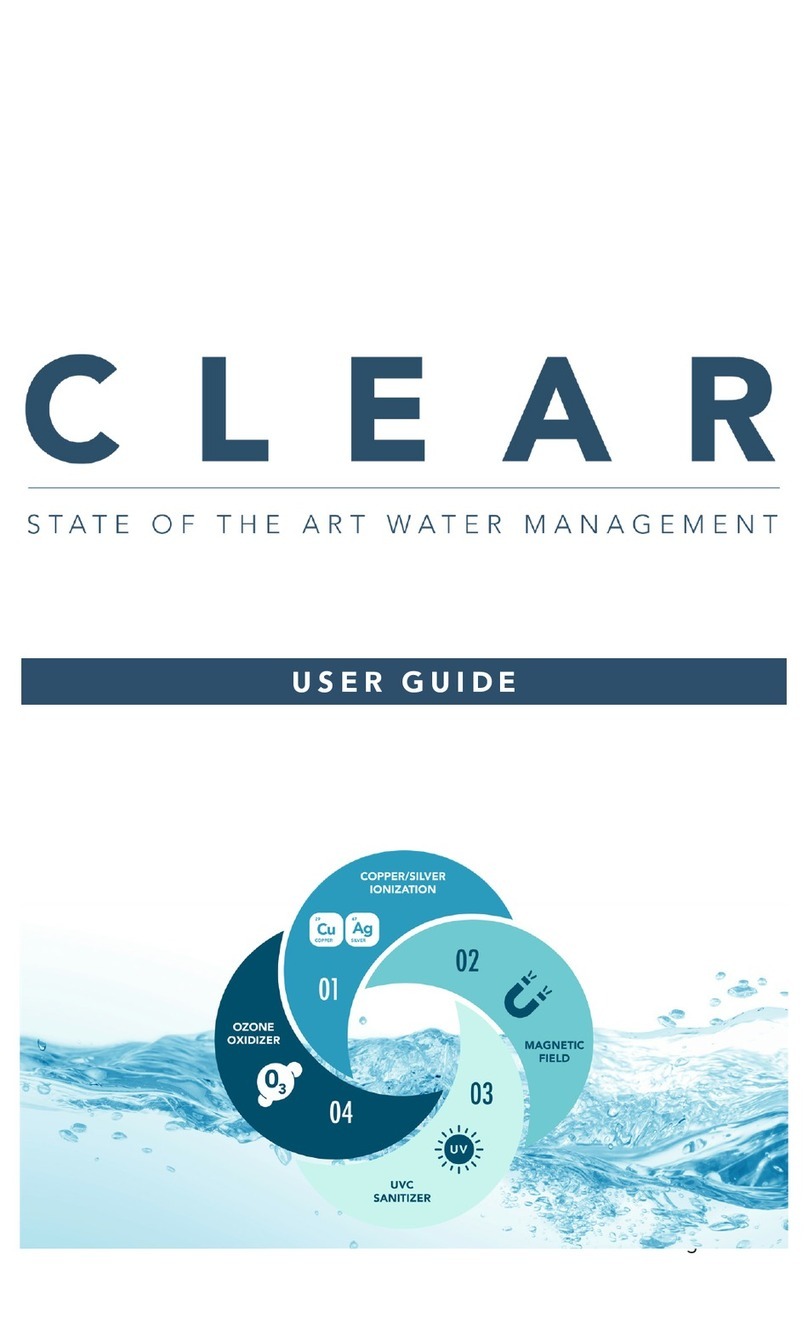
Clearwater Spas
Clearwater Spas CLEAR user guide

Taylex
Taylex ABS5000 installation manual
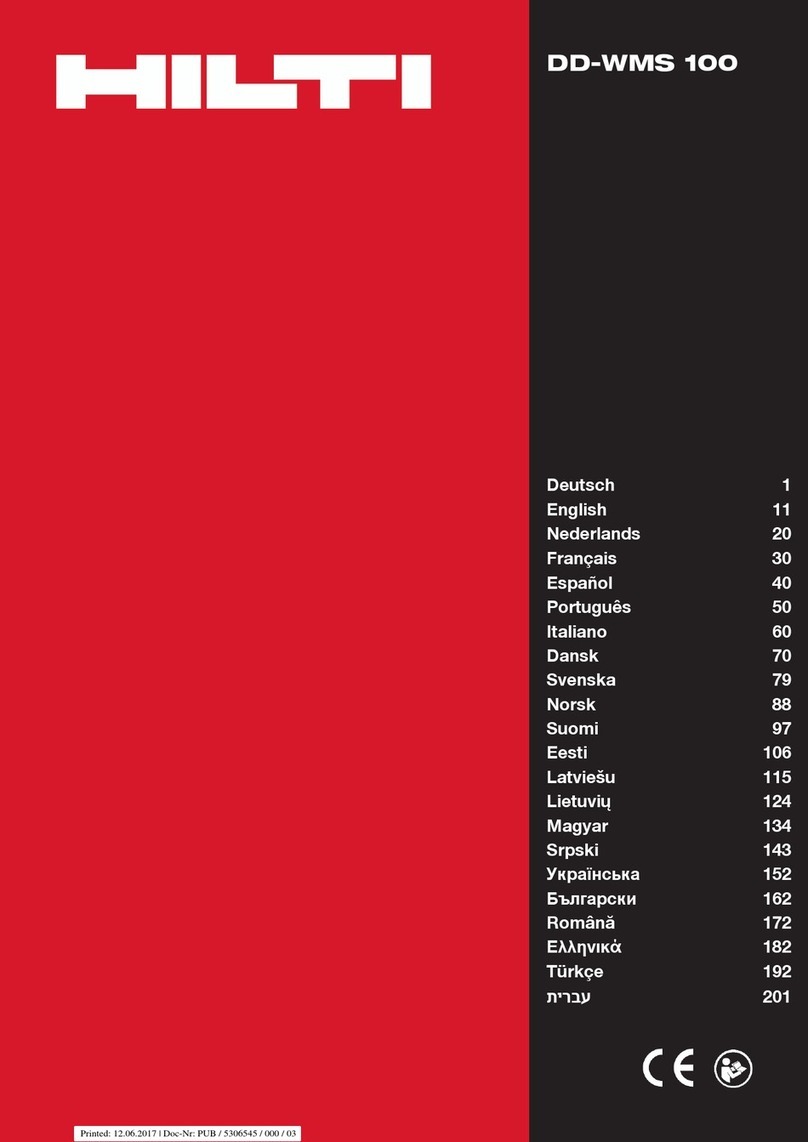
Hilti
Hilti DD-WMS 100 Original operating instructions
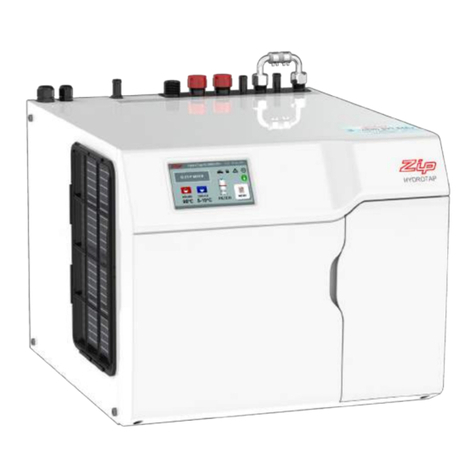
Zip
Zip HydroTap G4 Series installation instructions
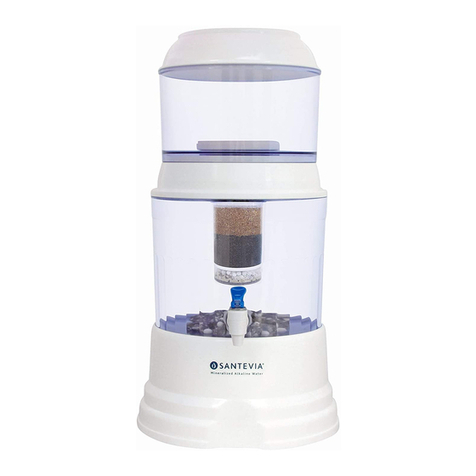
Santevia
Santevia Gravity Water System user manual
